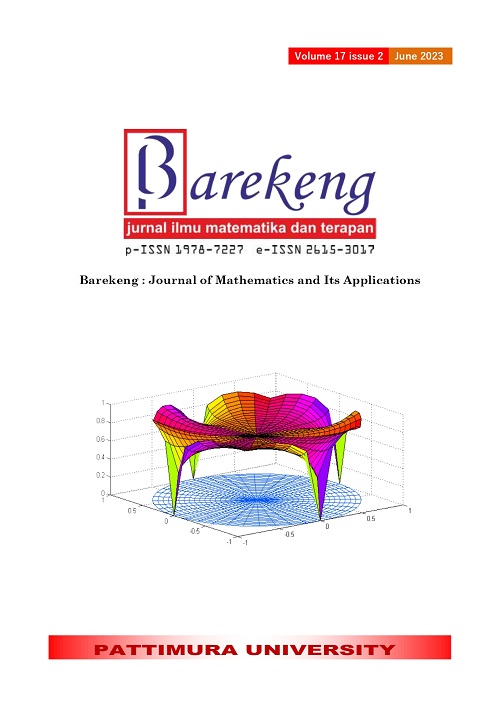SPACED REPETITION CONCEPT DESIGN WITH FUZZY MULTI CRITERIA ANALYSIS AS A MEDIA TO IMPROVE NUMERACY LEARNING FOR ELEMENTARY SCHOOL STUDENTS
Abstract
Numeracy Learning activities after the Covid-19 Pandemic has been decline in the quality of learning in a number of elementary school students. This research is limited to learning numeracy for low grade students, namely grade 1,2, and 3, because the basic concept of numeration begins with low grades There are several factors that make difficult for students to understand numeracy, the students often forget about the concepts that have been taught before. An Effective way of memorizing with the conventional way is memorizing with repeat pronunciations. To improve the quality of education, learning concepts that were previously carried out conventionally must be developed in a modern way using application. The purpose of this research is to improve the numeracy learning concept of low-grade students in primary school after Covid-19 pandemic which is more fun and modern by using the concept of spaced repetition based on android flashcards. The analysis of 135 student’s assessment is based on criteria such as tangible, reliability, empathy, responsive, and assurance. The decision support system using Fuzzy Multi Criteria Methods (MCDM) is also used to determine the weighting of the criteria and the effectiveness of learning using spaced repetition concept and it’s application. The result of the weighting using fuzzy multi criteria is obtained defuzzification that tangible 65.18, reliability 56.54, responsive 46.17, assurance 49.13, and empathy 29.62. Tangible has the highest results in this test, it means that the students prefer modern learning with android application with an attractive experienced. The correlation test obtained the result 0.76 which is a high value in decision making and could be accepted.
Downloads
References
D. T. D. Maya Nur Janah, “Literasi Numerasi dalam Pembelajaran Tematik,” J. Muallimuna, vol. 7, pp. 87–98, 2022.
R. dan T. Kementrian Pendidikan, Kebudayaan, “Modul Literasi Numerasi Di Sekolah Dasar,” Modul Literasi Numer. Di Sekol. Dasar, vol. 1, p. 22, 2021, [Online]. Available: http://ditpsd.kemdikbud.go.id/upload/filemanager/2021/06/2 Modul Literasi Numerasi.pdf
N. Z. Salvia, F. P. Sabrina, and I. Maula, “Analisis Kemampuan Literasi Numerasi Peserta Didik Ditinjau Dari Kecemasan Matematika,” ProSANDIKA UNIKAL …, no. 2019, 2022, [Online]. Available: https://www.proceeding.unikal.ac.id/index.php/sandika/article/view/890
D. W. Adinda and I. Oktaviyanti, “Profil Kemampuan Numerasi Dasar Siswa Sekolah Dasar Di SDN Mentokan,” vol. 7, pp. 1066–1070, 2022.
F. T. P. Pangesti, “Menumbuhkembangkan Literasi Numerasi Pada Pembelajaran Matematika Dengan Soal Hots,” Indones. Digit. J. Math. Educ., vol. 5, no. 9, pp. 566–575, 2018, [Online]. Available: http://idealmathedu.p4tkmatematika.org
U. Umar and A. Widodo, “Analisis Faktor Penyebab Rendahnya Kemampuan Akademik Siswa Sekolah Dasar di Daerah Pinggiran,” J. Educ. FKIP UNMA, vol. 8, no. 2, pp. 458–465, 2022, doi: 10.31949/educatio.v8i2.2131.
J. Hanks and P. Zhan, “The Forgetting Curve and Learning Algorithms,” pp. 53–60, 2012.
J. Kumamoto, “Vocabulary Trainer Using an Online Flashcard Site,” pp. 1–8, 1972.
A. Hidayat and N. M. S. Iswari, “Rancang Bangun Spaced Repetition Software untuk Menghafal Huruf Jepang Menggunakan Algoritma Supermemo 2 Berbasis IOS,” J. Ultim. InfoSys, vol. 9, no. 1, pp. 32–36, 2018, doi: 10.31937/si.v9i1.846.
C. C. Astuti and R. S. Untari, “Applied Hierarchical Cluster Analysis with Average Linkage Algoritm,” vol. 5, no. November, pp. 1–7, 2017.
L. Santya, M. Miftah, V. Mandala, S. Saepudin, and D. Gustian, “Penerapan Metode Fuzzy Mamdani untuk Pendukung Keputusan Penentuan Jumlah Produksi Lantak Si Jimat,” J. Rekayasa Teknol. Nusa Putra, vol. 7, no. 1, pp. 35–41, 2019.
N. L. Azizah, B. H. Prasojo, and C. S. Rini, “Analisis Tingkat Kepuasan Publik Terhadap Pelayanan Rumah Sakit Berdasarkan Metode Fuzzy Topsis Mcdm,” J. Ilm. Soulmath J. Edukasi Pendidik. Mat., vol. 7, no. 1, pp. 63–74, 2019, doi: 10.25139/smj.v7i1.1429.
M. K. Hidayat and S. Natalia, “Fuzzy Multi Atribute Decision Making Dengan Metode Simple Additive Weighted Untuk Penilaian Siswa Terbaik di TK Harapan Mulia Bekasi,” IJCIT (Indonesian J. Comput. Inf. Technol., vol. 3, no. 1, Mei , ISSN: 2527-449X, E-ISSN: 2549-7421, pp. 55–62, 2018.
N. Febriany, “BAB III Metode Fuzzy Mamdani,” 2016.
Sanusi and J. Husna, “Sistem Pengambilan Keputusan Menggunakan Topsis Fuzzy Mcdm Untuk Pemilihan Tempat Wisata Berbasis Web,” J. Ilm. Rekayasa dan Manaj. Sist. Inf., vol. 4, no. 1, pp. 26–35, 2018, [Online]. Available: http://ejournal.uin-suska.ac.id/index.php/RMSI/article/view/4889/2965
I. K. Putri, “Aplikasi Metode Fuzzy Min-Max (Mamdani) Dalam Menentukan Jumlah Produksi Perusahaan,” J. Ilm. d’Computare, vol. 9, pp. 30–38, 2019.
J. M. Adnan.K, Afandi F, “Hubungan Kemampuan Literasi Numerasi dengan Hasil Belajar Matematika Siswa Kelas V SD Gugus II,” pp. 423–430, 2021.
T. Nempung, T. Setiyaningsih, and N. Syamsiah, “Otomatisasi Metode Penelitian Skala Likert Berbasis Web,” no. November, pp. 1–8, 2015.
Copyright (c) 2023 Nuril Lutvi Azizah, Vevy Liansari, Alfan Indra Kusuma

This work is licensed under a Creative Commons Attribution-ShareAlike 4.0 International License.
Authors who publish with this Journal agree to the following terms:
- Author retain copyright and grant the journal right of first publication with the work simultaneously licensed under a creative commons attribution license that allow others to share the work within an acknowledgement of the work’s authorship and initial publication of this journal.
- Authors are able to enter into separate, additional contractual arrangement for the non-exclusive distribution of the journal’s published version of the work (e.g. acknowledgement of its initial publication in this journal).
- Authors are permitted and encouraged to post their work online (e.g. in institutional repositories or on their websites) prior to and during the submission process, as it can lead to productive exchanges, as well as earlier and greater citation of published works.






1.gif)



